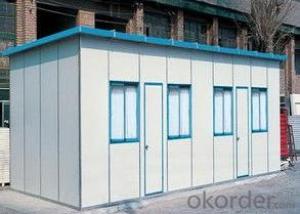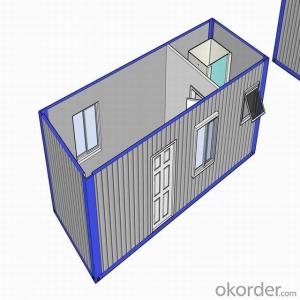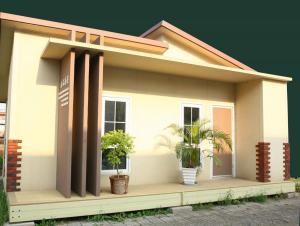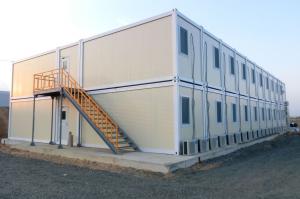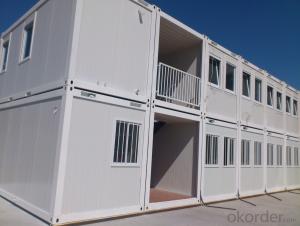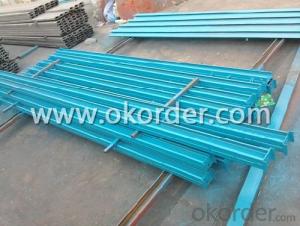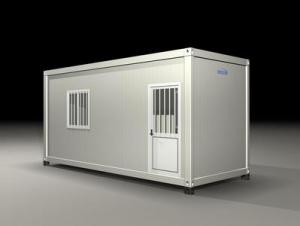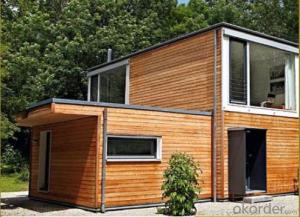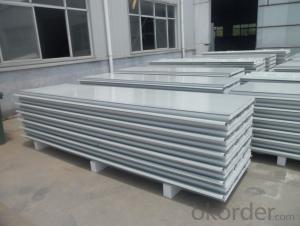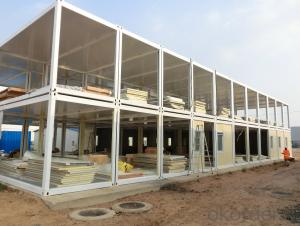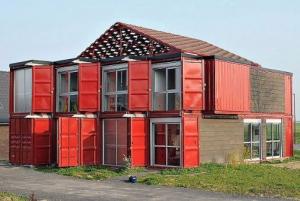Modular Container Home
- Loading Port:
- China Main Port
- Payment Terms:
- TT OR LC
- Min Order Qty:
- -
- Supply Capability:
- -
OKorder Service Pledge
OKorder Financial Service
You Might Also Like
Container House & HOME
Lifetime | 20-25 years |
Steel Frame | 4mm thickness steel pillar (baking finish)+3mm steel beam (Hot-galvanized) |
Wall Panel | 60mm EPS/Rockwool/PU sandwich panel |
Roof | (1)First layer: 0.5mm Hot-galvanized steel sheet (2)Second layer: 100mm glass wool insulation (3)Third layer: 50mm EPS/PU/Rockwool Sandwich Panel |
Bottom | (1)First layer:1.8 mm PVC floor (2)Second layer:18mm plywood for office,living etc. Cement fiberboard for bathroom with good water-proof (3)Third layer:100mm Insulation (4)Forth layer:0.5mm Hot-galvanized steel sheet |
Door/windows | one steel door and two PVC sliding windows |
Electricity | (1)1 distribution box;1 circuit breaker; (2)2 Ceiling lights ; 3 sockets(1 is A/C socket); (3)1 switch; |
Usage | Accommodation,office,living room,hotel,meeting room, dormitory, shop, booth, toilet, storage, kitchen, shower room and so on. |
Package | (1) 4 sets Flat-packing without shipping container (2) 6 sets loading in 40'High shipping Container; (3)The inner shower room and other furniture will be packed separately in shipping container.
|
- Q: Are container houses considered sustainable housing options?
- Yes, container houses are considered sustainable housing options. They are made from repurposed shipping containers, which reduces waste and carbon emissions associated with traditional construction materials. Additionally, container houses can be designed to be energy-efficient, incorporating solar panels, rainwater harvesting systems, and insulation to lower environmental impact.
- Q: What is the advantage of the container module room?
- Low cost, low cost, quality and cheap. Can be stacked to use, can be stacked 7 high.
- Q: Can container houses be designed with a traditional or historical theme?
- Certainly, container houses can be designed with a traditional or historical theme without a doubt. While shipping container homes are commonly associated with modern and minimalist designs, there are no limitations on the style or theme that can be applied to these structures. By employing the appropriate design elements, materials, and finishes, container houses can be transformed to exemplify traditional or historical aesthetics. To achieve a traditional or historical theme, it is possible to incorporate various architectural elements into the design. For instance, the exterior of the container house can be covered with timeless materials like brick, stone, or timber, giving it an everlasting appearance. Additionally, historical architectural features such as gables, dormer windows, or ornamental details can be introduced to enhance the overall design. The interior of the container house can also be fashioned with a traditional theme by utilizing appropriate materials, colors, and furnishings. For example, a rustic or vintage atmosphere can be created by incorporating reclaimed wood or antique furniture. To evoke a sense of history, traditional moldings, wainscoting, or decorative wallpapers can be added to the walls. Moreover, the landscaping and outdoor design can contribute to the traditional or historical theme of a container house. To establish a charming and nostalgic ambiance, traditional garden elements like well-manicured lawns, flower beds, or hedges can be integrated into the surroundings. In conclusion, container houses can absolutely be designed with a traditional or historical theme. By thoughtfully considering and making creative design choices, these structures can seamlessly blend into their environment and reflect the desired aesthetic.
- Q: Are container houses prone to rusting?
- Container houses are typically made of steel, which is known to be susceptible to rusting. However, with proper maintenance and treatment, container houses can be protected against rusting. Most container houses undergo a process called corten steel treatment, which involves the application of a protective layer to prevent rust formation. Additionally, regular inspections and maintenance can help identify and address any potential rusting issues. It is important to note that the durability and longevity of a container house depend on various factors including the quality of the steel used, climate conditions, and maintenance efforts. Overall, while container houses can be prone to rusting, proper care and maintenance can ensure their longevity and structural integrity.
- Q: Are container houses suitable for areas with limited access to grocery stores?
- Yes, container houses can be a suitable option for areas with limited access to grocery stores. Container houses are designed to be self-sufficient and can be equipped with various amenities to meet the needs of the residents. For example, container houses can be designed with a small kitchen area where residents can store and prepare food. Additionally, container houses can also be equipped with a water filtration system to ensure access to clean water. Furthermore, container houses can be built with a small garden or rooftop space for residents to grow their own vegetables and fruits, reducing reliance on grocery stores. Overall, container houses can provide an efficient and sustainable solution for areas with limited access to grocery stores, allowing residents to have more control over their food supply.
- Q: Are container houses safe from extreme weather conditions?
- Container houses can be designed and built to be safe and secure in extreme weather conditions. With proper insulation, reinforced structures, and additional features, container houses can withstand hurricanes, earthquakes, and other natural disasters. Some container homes are even designed to meet stringent building codes for high wind zones and seismic activity. One of the main advantages of container houses is their durability. Shipping containers are made of strong steel, designed to withstand the harsh conditions of sea transport. This inherent strength makes them resistant to wind, rain, and even fire. However, it is important to note that modifications and reinforcements are often necessary to ensure their safety in extreme weather conditions. For instance, container homes can be insulated with high-quality materials to provide effective thermal insulation, preventing heat loss or gain during extreme temperatures. Insulation also helps regulate the temperature inside the house, making it comfortable and safe to live in. In areas prone to hurricanes or tornadoes, container houses can be further secured by anchoring them to a solid foundation or using reinforced concrete footings. Additionally, adding storm shutters or impact-resistant windows can protect against flying debris during severe weather events. Earthquake-prone regions require additional precautions. Engineers can strengthen the container structure by welding or bolting steel beams to the containers to increase their stability. Proper seismic bracing and foundation design can ensure that the container home remains intact during an earthquake. It is crucial to work with experienced architects, engineers, and contractors who specialize in container homes, as they will have the expertise to design and construct a safe dwelling. By following proper building codes and regulations, container houses can provide a secure and reliable living space even in the face of extreme weather conditions.
- Q: Do container houses have plumbing and bathroom facilities?
- Yes, container houses can have plumbing and bathroom facilities. These houses can be customized and equipped with all necessary amenities, including plumbing systems for water supply and waste management, as well as bathroom fixtures such as toilets, sinks, and showers.
- Q: Can container houses be designed with a wine cellar or wine room?
- Certainly, container houses have the potential to incorporate a wine cellar or wine room in their design. Despite their limited space, container houses can be creatively customized to include specialized rooms such as a wine cellar. The modular and compact nature of container houses allows for adaptability and customization, making it feasible to integrate a wine cellar or wine room into the overall layout. One approach to designing a wine cellar in a container house involves utilizing the space beneath the main living area. By excavating a small section of the ground below the container, it becomes possible to create a temperature-controlled wine cellar. This underground location provides natural insulation, which plays a crucial role in maintaining a consistent temperature, vital for proper wine storage. Additionally, ventilation and humidity control systems can be installed to ensure optimum conditions for storing and aging wine. Another option is to convert a portion of the container itself into a wine cellar. By insulating the interior walls and installing racks or shelves, the container can be transformed into a suitable space for holding wine bottles. To enhance the wine cellar experience, climate control systems can be integrated to regulate temperature and humidity levels. Moreover, implementing proper lighting and security measures contributes to creating an aesthetically pleasing and secure wine storage area. Collaborating with professionals specializing in container house design and wine cellar construction is essential to ensure the structural integrity and functionality of a wine cellar in a container house. With meticulous planning and innovative design, container houses can successfully accommodate a wine cellar or wine room, enabling homeowners to relish their favorite wines in a distinctive and environmentally-friendly living space.
- Q: Can container houses be designed to be earthquake-resistant?
- Yes, container houses can be designed to be earthquake-resistant. By using proper engineering techniques and incorporating seismic design principles, container houses can be built to withstand seismic forces. This may include reinforcing the structure, using flexible foundation systems, and incorporating dampers or bracing mechanisms to absorb and dissipate earthquake energy.
- Q: Are container houses safe during earthquakes?
- If container houses are designed and built properly, they can offer safety during earthquakes. The safety of these houses in seismic events relies on various factors, including the integrity of the containers, the foundation they sit on, and the construction techniques employed. To enhance their earthquake resistance, container houses can be reinforced. Additional steel reinforcements can be incorporated into the corners and walls of the containers, increasing their structural strength. These reinforcements effectively distribute seismic forces throughout the structure, reducing the risk of collapse during an earthquake. Furthermore, the foundation of the container house plays a vital role in its earthquake safety. A robust and well-designed foundation can absorb and dissipate seismic energy, minimizing the impact on the structure. Anchoring the container house securely to the foundation is crucial to prevent it from sliding or toppling over during an earthquake. Moreover, the construction techniques employed in building container houses must adhere to local building codes and regulations. It is essential to have adequate insulation, fireproofing, and proper electrical and plumbing installations for the safety and functionality of the house. It is important to acknowledge that no structure can be completely immune to the destructive forces of a severe earthquake. However, with proper design, construction, and adherence to safety standards, container houses can offer a safe and durable living space during seismic events. Consulting with structural engineers and following local guidelines can ensure the safety of container houses in earthquake-prone areas.
Send your message to us
Modular Container Home
- Loading Port:
- China Main Port
- Payment Terms:
- TT OR LC
- Min Order Qty:
- -
- Supply Capability:
- -
OKorder Service Pledge
OKorder Financial Service
Similar products
Hot products
Hot Searches
Related keywords
